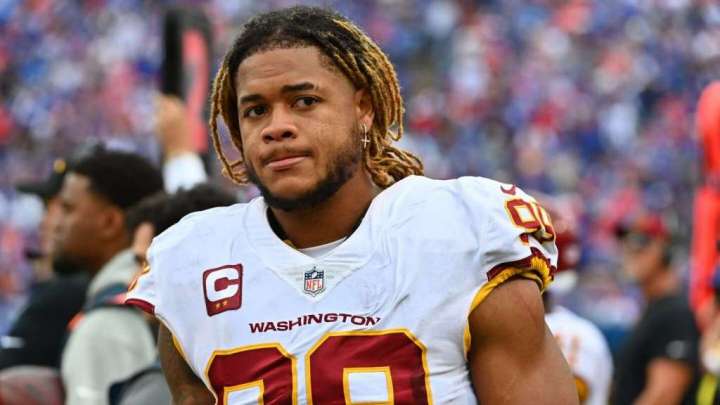Part of what Ron Rivera said about Chase Young sounded so natural that it’s easy to gloss over.
During Chase Young’s long road back, performance will outweigh personality

But on Wednesday, as he stood in shorts and sneakers under the relentless midday sun, no one could predict when Young’s next snap would come or what his production level would be when it did. His position in the organizational flowchart has to be what Rivera said it is — a veteran, a leader — because a rebuilding franchise can’t miss on the second pick in the draft.
Yet he has played just 24 NFL games. He is unable to participate in this spring’s offseason workouts because he is rehabilitating a torn ACL. He is, in a way, more of a work in progress — more of a question mark — now than he was at this time a year ago.
“That was last year,” Young said. “We on to this year.”
It makes sense for him to think of it that way. But put the questions about how his knee will respond — about how explosive he will be post-injury — aside for a minute. Last year colors how we view Young now because, before the injury, one of Washington’s most puzzling issues of 2021 was this: Why isn’t Chase Young producing?
A review of the numbers: In 15 games as a rookie, Young averaged 2.1 solo tackles. In the nine games of his second season, that dropped to 1.7. As a rookie, he had two tackles for loss every three games; that dropped to one every three games in 2021. His quarterback hits were essentially cut in half, and his sacks fell drastically — one every other game to just 1½ total in the nine games he played.
A year ago during training camp in Richmond, with fans crowding the sidelines after being kept away during the 2020 pandemic season, people clamored for Young, and his No. 99 jersey seemed ubiquitous. Give fans truth serum now, and they might be more concerned about whether the Commanders will sign wide receiver Terry McLaurin to a long-term deal than about Young’s progress.
Even while rehabbing, Young looks the part. When he gets back, he has to play it. His charisma is obvious. But in football, it takes more than personality to lead. It takes production.
“A lot of it, also, is the impact you make on the field,” Rivera said. “It’s a lot easier to lead, obviously, when things are easy. But when things are tough, it’s being able to find the right style of leadership. …
“So there’s a lot of things that he can glean from being out here and watching and seeing how things are happening. Today would have been a great day — an easy day — to lead. It’s when it’s the doldrums, it’s a drag, it’s hard to be out there, practice isn’t going well and you’re not having success on either side of the ball — and that’s the side that gets low. How do you build it back up?”
That’s where Young is: building it back up. During these relatively chill organized team activities, he said his role could be helping his fellow defensive ends — particularly his bookend, Montez Sweat — with details he can see from the outside but they don’t realize as a play unfolds. Was Sweat’s first stride too short? Are his pads at the right level?
“Just any tips I can give him,” Young said. “Just trying to be a good teammate.”
It all makes you think: The best way Chase Young could be a good teammate would be to become the player he’s supposed to be. That would lift up the locker room in a way no speech, no outside assessment, ever could.
It’s instructive to remember how Rivera was assessing Young and Sweat right before Young’s season-ending injury in November.
“They need to stop pressing and trust their teammates,” Rivera told the team’s website at the time. “… Sometimes Chase starts outside and plants his leg and cuts inside — because he’s trying to make a play — and the quarterback gets flushed to the outside. If Chase stays outside, he has an easy sack, but instead he dives underneath.”
The injury and the lost time don’t make those tendencies evaporate, and we have no new evidence to show whether Young has learned from those mistakes. So it’s imperative, a year after Young skipped OTAs to work out on his own, that his presence in Ashburn now isn’t merely to get back to running and doing some squats — the physical part of rehab. It’s essential that he understands what wasn’t working in the half season before he went down — and fix it.
He is saying all of the right things.
“Even while I’m out on the field standing with [defensive coordinator Jack] Del Rio, listening to every call, watching every guy — what he’s supposed to do,” Young said. “Even me looking at [Sweat], watching him, even watching Jon [Allen, the defensive tackle]. Just watching how they move, and just being here, man. I feel like being here and just watching and being out on the field is the biggest thing.”
Just being here is a step for Chase Young. But this fall, his presence will need to be accompanied by production. His standing in the locker room and the organization will be unquestioned only if he provides the performance to go with it.






